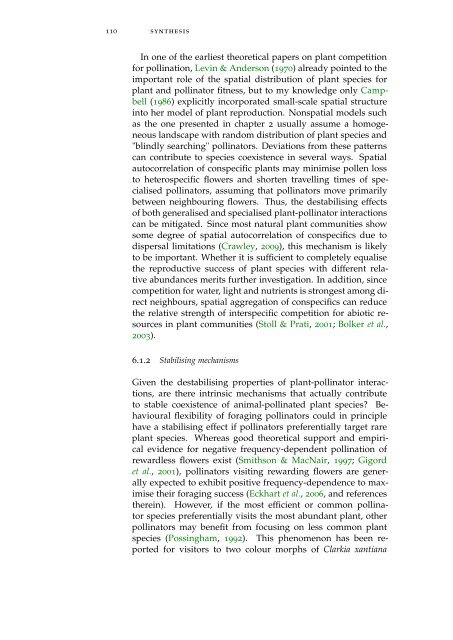Linking Specialisation and Stability of Plant ... - OPUS Würzburg
Linking Specialisation and Stability of Plant ... - OPUS Würzburg
Linking Specialisation and Stability of Plant ... - OPUS Würzburg
You also want an ePaper? Increase the reach of your titles
YUMPU automatically turns print PDFs into web optimized ePapers that Google loves.
110 synthesis<br />
In one <strong>of</strong> the earliest theoretical papers on plant competition<br />
for pollination, Levin & Anderson (1970) already pointed to the<br />
important role <strong>of</strong> the spatial distribution <strong>of</strong> plant species for<br />
plant <strong>and</strong> pollinator fitness, but to my knowledge only Campbell<br />
(1986) explicitly incorporated small-scale spatial structure<br />
into her model <strong>of</strong> plant reproduction. Nonspatial models such<br />
as the one presented in chapter 2 usually assume a homogeneous<br />
l<strong>and</strong>scape with r<strong>and</strong>om distribution <strong>of</strong> plant species <strong>and</strong><br />
"blindly searching" pollinators. Deviations from these patterns<br />
can contribute to species coexistence in several ways. Spatial<br />
autocorrelation <strong>of</strong> conspecific plants may minimise pollen loss<br />
to heterospecific flowers <strong>and</strong> shorten travelling times <strong>of</strong> specialised<br />
pollinators, assuming that pollinators move primarily<br />
between neighbouring flowers. Thus, the destabilising effects<br />
<strong>of</strong> both generalised <strong>and</strong> specialised plant-pollinator interactions<br />
can be mitigated. Since most natural plant communities show<br />
some degree <strong>of</strong> spatial autocorrelation <strong>of</strong> conspecifics due to<br />
dispersal limitations (Crawley, 2009), this mechanism is likely<br />
to be important. Whether it is sufficient to completely equalise<br />
the reproductive success <strong>of</strong> plant species with different relative<br />
abundances merits further investigation. In addition, since<br />
competition for water, light <strong>and</strong> nutrients is strongest among direct<br />
neighbours, spatial aggregation <strong>of</strong> conspecifics can reduce<br />
the relative strength <strong>of</strong> interspecific competition for abiotic resources<br />
in plant communities (Stoll & Prati, 2001; Bolker et al.,<br />
2003).<br />
6.1.2 Stabilising mechanisms<br />
Given the destabilising properties <strong>of</strong> plant-pollinator interactions,<br />
are there intrinsic mechanisms that actually contribute<br />
to stable coexistence <strong>of</strong> animal-pollinated plant species? Behavioural<br />
flexibility <strong>of</strong> foraging pollinators could in principle<br />
have a stabilising effect if pollinators preferentially target rare<br />
plant species. Whereas good theoretical support <strong>and</strong> empirical<br />
evidence for negative frequency-dependent pollination <strong>of</strong><br />
rewardless flowers exist (Smithson & MacNair, 1997; Gigord<br />
et al., 2001), pollinators visiting rewarding flowers are generally<br />
expected to exhibit positive frequency-dependence to maximise<br />
their foraging success (Eckhart et al., 2006, <strong>and</strong> references<br />
therein). However, if the most efficient or common pollinator<br />
species preferentially visits the most abundant plant, other<br />
pollinators may benefit from focusing on less common plant<br />
species (Possingham, 1992). This phenomenon has been reported<br />
for visitors to two colour morphs <strong>of</strong> Clarkia xantiana
















